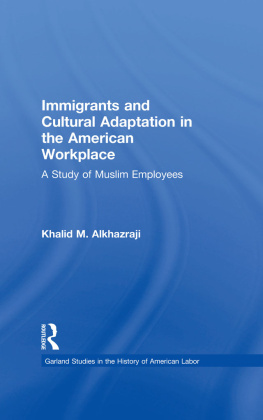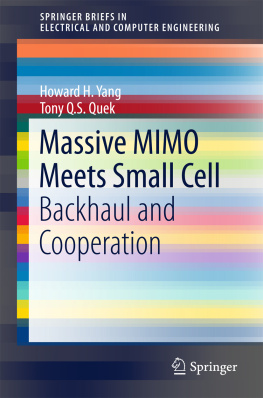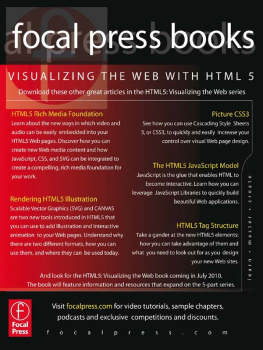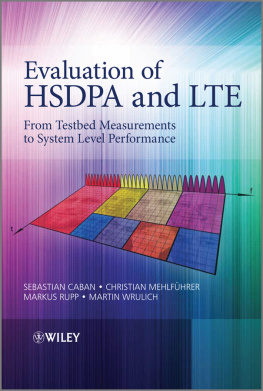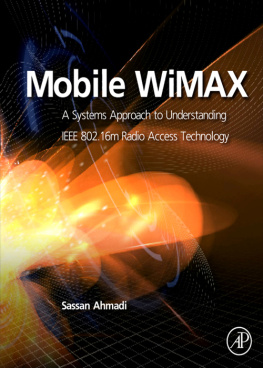Mobile WiMAX Systems
Performance Analysis of Fractional Frequency Reuse
Mobile WiMAX Systems
Performance Analysis of Fractional Frequency Reuse
M. K. Salman Alnaimi
Abid Yahya
With contributions from
R. Badlishah Ahmad

CRC Press
Taylor & Francis Group
6000 Broken Sound Parkway NW, Suite 300
Boca Raton, FL 33487-2742
2014 by Taylor & Francis Group, LLC
CRC Press is an imprint of Taylor & Francis Group, an Informa business
No claim to original U.S. Government works
Printed on acid-free paper
International Standard Book Number-13: 978-0-8153-4802-3 (Hardback)
This book contains information obtained from authentic and highly regarded sources. Reasonable efforts have been made to publish reliable data and information, but the author and publisher cannot assume responsibility for the validity of all materials or the consequences of their use. The authors and publishers have attempted to trace the copyright holders of all material reproduced in this publication and apologize to copyright holders if permission to publish in this form has not been obtained. If any copyright material has not been acknowledged please write and let us know so we may rectify in any future reprint.
Except as permitted under U.S. Copyright Law, no part of this book may be reprinted, reproduced, transmitted, or utilized in any form by any electronic, mechanical, or other means, now known or hereafter invented, including photocopying, microfilming, and recording, or in any information storage or retrieval system, without written permission from the publishers.
For permission to photocopy or use material electronically from this work, please access (http://www.copyright.com/) or contact the Copyright Clearance Center, Inc. (CCC), 222 Rosewood Drive, Danvers, MA 01923, 978-750-8400. CCC is a not-for-profit organization that provides licenses and registration for a variety of users. For organizations that have been granted a photocopy license by the CCC, a separate system of payment has been arranged.
Trademark Notice : Product or corporate names may be trademarks or registered trademarks, and are used only for identification and explanation without intent to infringe.
Library of Congress Cataloging-in-Publication Data
Names: Fadhil, Mohammed Khalid Salman, author. | Yahya, Abid, author.
Title: Mobile WiMAX systems : performance analysis of fractional frequency reuse / Mohammed Khalid Salman Fadhil, Abid Yahya.
Description: Boca Raton, FL : CRC Press/Taylor & Francis Group, 2019. | A CRC title, part of the Taylor & Francis imprint, a member of the Taylor & Francis Group, the academic division of T&F Informa plc. | Includes bibliographical references and index.
Identifiers: LCCN 2018014272| ISBN 9780815348023 (hardback : acid-free paper) | ISBN 9781351026628 (ebook)
Subjects: LCSH: Orthogonal frequency division multiplexing. | IEEE 802.16 (Standard) | Mobile communication systems. | Radio resource management (Wireless communications)
Classification: LCC TK5103.484 .F33 2019 | DDC 621.3845/6--dc23
LC record available at
Visit the Taylor & Francis Web site at
http://www.taylorandfrancis.com
and the CRC Press Web site at
http://www.crcpress.com
This book is gratefully dedicated to my children, my wonderful wife,
and my mother and father, who taught me how to be a man.
M. K. Salman Alnaimi
Dedicated to my family for their love, support, and sacrifice along the path
of my academic pursuits, especially to my father, who took me to school.
Abid Yahya
Contents
Broadband wireless connections have emerged as a solution to satisfy users demands for modern E-applications, such as Long Term Evolution (LTE) and Worldwide Interoperability for Microwave Access (WiMAX). According to Ericssons official projection, global mobile broadband subscriptions will reach 6.5 billion by the end of 2018. This orientation of the public toward wireless broadband Internet services needs more attention in terms of adequate resources and bandwidth to meet users demands for modern E-services. The world is rapidly moving toward the use of mobile phone applications, and global telecom companies are competing to provide the best services to users. Optimal use of the bandwidth package and available radio resources is the goal of these companies, as they are always working to improve them to match users requirements. Radio resources are valuable; there is a need for more adaptive and reconfigurable solutions for better exploiting resources in the network, especially when we are talking about the wireless network, since the control signal occupies a significant portion of the bandwidth.
Most of the problems that hinder the best use of radio resources in the cellular network lie in the frequency interference between mobile phone base stations, which results in reduced cell capacity and limits the service quality of cell edge users. Many methods have been proposed to overcome the intercell interference problem. Fractional frequency reuse (FFR) is one of the methods used by WiMAX and LTE technology. FFR is not restricted to WiMAX; it can be used by any mobile technology to address the problem of intercell interference, which is a matter of controlling frequency and time.
An IEEE 802.16e WiMAX base station uses FFR to enhance the capacity and signal quality of cell edge users. Even though FFR is important to use in cellular systems, it has some drawbacks. For this reason, the first chapter of the book explains the principle of intercell interference, the FFR technique, and the problem associated with current FFR. Then Chapter 2 describes the types of FFR, FFR resource assignment challenges in the orthogonal frequency-division multiple access (OFDMA) network, and how to enhance the utilization of radio resources in FFR.
The WiMAX physical layer theory has become an important part of wireless network research, because most of the wireless protocols function there. The most important fetchers of the WiMAX physical layer are related to designing the FFR technique and are presented in Chapter 3, which is very important for understanding, modifying, or enhancing the FFR technique.
Modern mobile communications technology can use two types of frame configuration to match cell load: static and dynamic. In the static configuration, the frame information is changed every several hours or possibly every several days. On the contrary, in the dynamic configuration the frame information is changed frame by frame to match the cell load. Chapter 4 presents the design and implantation of two new FFR algorithms: static resource assignment (SRA) and dynamic resource assignment (DRA). Comprehensive mathematical models are discussed that are not included or clearly explained in other books on WiMAX. Readers can take advantage of these mathematical models in designing, developing, or even applying them to other wireless network systems for different purposes. For future development, this chapter also covers topics like how to effectively model the channel capacity of a cellular network, and the cellular network of 19 base stations.
The results of the proposed algorithms are demonstrated in Chapter 5. In fact, these results represent the outputs of the mathematical models. The chapter shows the effort of the new FFR algorithms in the cellular network of 19 base stations. Also, these algorithms are tested by applying three types of WiMAX system parameters, such as 5, 10, and 20 MHz system bandwidth.
We thank the following individuals; without their contributions and support, this book could not have been written.
We would like to express their special gratitude and thanks to the Ministry of Higher Education and Scientific Research and Science and Technology, Iraq; Botswana International University of Science and Technology (BIUST); and Universiti Malaysia Perlis (UniMAP), Sarhad University of Science and Information Technology (SUIT), Peshawar, for giving us the attention, time, and opportunity to publish this book.
Next page

